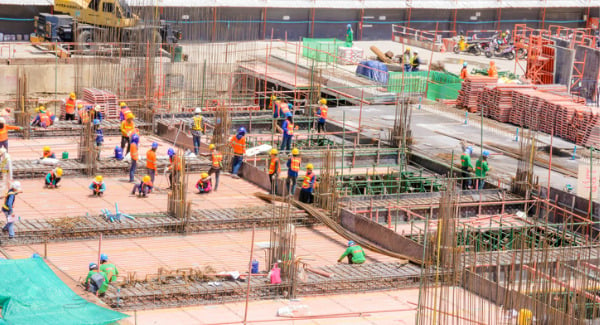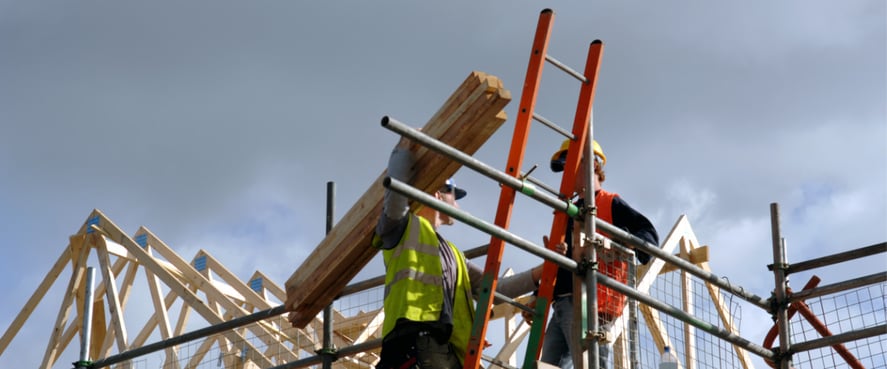
Construction companies have been struggling to fill positions for years, and those human resources struggles are projected to continue for AEC companies around the globe.
A survey conducted by the Association of General Contractors of America in 2021 outlined the most notable effects of the skilled labor shortage in construction in the midst of the pandemic:
- 72% say that projects are taking longer than anticipated
- 84% of companies have seen higher project costs
- 83% cited inexperienced skilled labor or workforce shortages as a health and safety challenge
Short-Term Trends Exacerbate an Old Problem
In Europe, demand for labor, as measured by the job vacancy rate, reached pre-pandemic levels during the first quarter of 2021 and the job vacancy rate is escalating in the construction sector.
Job vacancies for the construction sector peaked in Q3 2019 at just more than 3.5%. It dipped to about 2.75% in Q2 2020 and has for the remainder of 2021 been on a curvy upward trajectory toward 3.0%, according to Eurofound— the European Foundation for the Improvement of Living and Working Conditions.
The job vacancy rate for construction has been consistently low for years; this is due to the chronic labor shortages experienced by the construction industry in both Europe and North America.
Despite grappling with these issues, public and private investment in the built environment is high as governments on both sides of the Atlantic attempt to stimulate their economies and companies participate in global economic growth.
According to the Construction Products Association’s 2021 Summer Forecast, construction output in the UK was expected to rise by 6.3% in 2022 after rising by 13.7% in 2021.
While a welcome development, this will only exacerbate the chronic skills shortage already occurring in the UK construction industry.
What is causing this skills shortage? Some short-term influences on the skilled worker shortage include COVID-19 safety protocols, government restrictions, an undersupply of building materials, supply chain issues, and Brexit.
How? Brexit has decreased the potential work pool for construction labor. Supply chain issues combined with an undersupply of building materials has prolonged project completion rates. This has a negative supply on labor demand but also makes it more difficult to schedule skilled labor.
When it comes to COVID-19, safety protocols combined with government restrictions have the same effect.
While the pandemic may have created many new construction opportunities—home remodels took off as people began spending the majority of their time indoors, and then once return to work took shape, offices needed to be reworked to allow for social distancing—bridging the skills gaps in the construction industry still took a COVID-sized hit.

Labor Pains on Both Sides of the Pond
In North America, the construction labor market is much the same. They are experiencing the same short-term trends and the chronic shortage of workers as the UK.
Coupled with the U.S.’s Build Back Better motto driving political decisions that affect the economy and President Joe Biden’s one trillion-dollar infrastructure program, demand for construction labor is set to skyrocket.
This will make finding skilled workers even more challenging for an industry that claims 83% of construction firms have difficulty filling positions, according to a recent report published by the Associated General Contractors of America (AGC).
The U.S. is experiencing labor shortages in other sectors as well. As the ‘Great Resignation’ takes shape, workers leaving their jobs are at record highs, yet the number of job seekers remains low. The U.S. added more than 6.4 million jobs—more than any other calendar year—so the pool of people from which to draw from is small.
In this new job market, the bargaining power lies in the hands of the employees and these workforce demands are driving up wages. Nearly 40 metros are projected to experience construction occupation wage growth of more than 4.5%, according to ThinkWhy’s 2022 U.S. Job Market Outlook report.

How Did We Get Here?
Recent events, such as COVID-19, have only exacerbated a chronic human resources (HR) problem for the construction industry.
Companies in the construction industry generally pay employees well—usually at a higher rate than many other sectors. The average hourly construction wage typically runs over $30 an hour in the U.S., according to the Bureau of Labor Statistics.
The gap between the number of people being trained in the skilled trades and the number of people retiring from the skilled trades has been growing for more than a decade. It doesn’t take a mathematician to figure out this will eventually lead to a skilled labor shortage. Population growth also exacerbates the problem.
Numerous people in the industry have pointed to what can be called the dismantling of trades training and exposure at the lower levels of education.
For decades, across the U.S., schools and school boards have been moving away from courses that build the foundation for the trades, such as woodworking or shop. This has decreased people’s exposure to these skills and decreases the chances they will choose a career in which those skills will be employed.
At the same time, there has been a lot of messaging that targets students about their higher education and career options. Young people are taught being a plumber or electrician is sub-par and to truly succeed and be happy in life one should pursue a career that requires a college degree—not an apprenticeship.
To many not in the construction industry, construction jobs are seen as dirty, unsafe, old-fashioned, dead-end jobs. This old-fashioned and negative outlook could play a huge role in why people don’t pursue jobs in construction.

A Multi-Pronged, Multi-Year Solution
There is no easy solution to the skilled labor shortage.
But with the problem becoming more and more prevalent, here are four things companies can do to start addressing the issue:
1. Boost Salaries
In the short term, companies can mitigate the effects of the skilled labor shortage on their projects by posting job opportunities with industry-leading salaries.
With the current job market becoming more and more competitive, jobs offering higher salaries will often win out. While this will help your company find the talent it needs, it may not have such a positive effect on the industry as a whole.
2. Increase Apprenticeship Programs and Incentivize Training
The next step companies can take is to upskill their current employees and/or offer (more) apprenticeships. If you have good employees who lack certain skills, it may be worth your company’s while to pay for or incentivize their training.
Likewise, if companies offer more apprenticeships, the industry would produce more trained professionals plus boost enrolment in apprenticeship programs. However, both of these solutions rely on having either the unskilled labor or the students from which to draw upon.
3. Get Young People Interested
The third step that companies or individuals can take is to advocate for the industry by writing or meeting with local schools and writing or meeting with local politicians, as well as joining or creating a trades training outreach program through an industry association.
4. Use Tech to Your Advantage
The final step in mitigating the impact of the skilled labor shortage on your company is by adopting certain equipment and technologies that decrease labor needs.
Buying a small excavator and hiring one operator could perform the same work as a three-person crew equipped with hand tools. By using a drone, you can eliminate the need for a site surveyor.
By implementing project management software, you can decrease the time it takes to perform a host of activities, thereby making your crew more productive and decreasing labor needs.
Want to learn more about how tech can help address the skills shortage on your project? Book a demo now.
Nathan Medcalf
Nathan Medcalf writes about technology, heavy equipment, and construction for numerous clients and has been published in more than 30 trade publications since 2006.
4 minute read
Asite Insights in your inbox.
Sign up for product news and our latest insights published monthly. It's a newsletter so hot, even global warming can't keep up.



